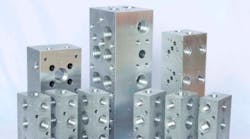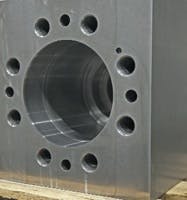O'Rourke explains that ductile iron is a continuous-cast material with strength comparable to that of plain carbon and free-machining steels. However, because it is more machinable than steel, ductile iron can save substantial cost by reducing machining time, extending tool life, or both.
Along with better machinability, ductile iron also produces fewer burrs from drilling, reveals Gordon Weiler, of Daman Products Co., Mishawaka, Ind. Hydraulic manifolds usually require many intersecting holes, so complete burr removal is essential, but it can add substantial cost to a manifold. However, burr removal is easier with ductile iron, which further adds to cost savings, especially with manifolds.
Another benefit, adds Bill Calcagno, of Selling Precision, West Milford, N.J., a producer of custom hydraulic manifolds, is that unlike hot-rolled steels, continuouscast ductile iron does not require ultrasonic testing prior to machining. He says that hot-rolled steels contain sulphur and other agents to enhance machinability. However, these agents can produce inclusions — discontinuities or cavities within the structure that could turn a highly machined manifold intro scrap. Because 65-45-12 ductile iron (the type most widely used for hydraulic manifolds) does not require these machinability agents, manifold producers generally can forego the expense of ultrasonic testing.
However, Calcagno explains that ductile iron cannot replace steel in every instance. "If you'll be welding something to a machined manifold, you'll go with steel because it has much better weldability. The additional cost to weld ductile iron more than offsets any cost advantage from machinability in most cases."
Finally, Weiler points out that another reason for the more widespread use of ductile iron is availability. "Size often dictated whether we would use steel or ductile iron. If a manifold had to be larger than a certain size, we had to go with steel. Now, however, we've been able to make manifolds with a cross section as large as 25 in. square, and we anticipate being able to continue increasing that."
For more technical information on ductile iron, visit the Ductile Iron Society at www.ductile.org. In addition to explaining the technology, properties, and characteristics of ductile iron, this website also offers a comprehensive eBook, Ductile Iron Data for Design Engineers, that can be downloaded for free.


